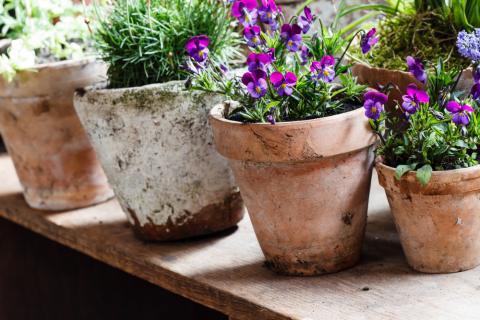
Many of us dream of having a garden, but if you live in a small apartment or house without a yard, it’s very hard to find the space you need to start growing vegetables, herbs, and anything else you need for your cooking. While some people just give up at this point, there’s something you should know: most vegetables can be grown in containers!
It’s true, and the process is not difficult at all. Knowing which containers to use for each plant is the only difficult part. Read on to find out everything you need to know about growing a thriving garden in simple containers.
People have been getting more and more creative with their gardening techniques. The motivations for this kind of movement often involve water conservation and pollution prevention. It all starts with understanding the best placement for your container garden.
Most plants need full sun for at least six hours a day. Tomatoes, peppers, and various other plants also benefit from air circulation to prevent rotting or disease. Depending on the climate of your home, you should ensure that a cement area doesn’t get too hot during the day.
Since these types of gardens are very portable, you can easily move them as needed from one place to another as the conditions change. Once you’ve decided on a location, it’s time to get your containers in order.
How to Get the Most Out of Your Container Garden
1. Choose Big Pots
While the visible part of a plant may be small, the network of roots is very large. The larger the plant, the larger the pot that you will need to ensure it grows healthy. If you choose a very large container, you can even grow several small plants in the same pot.
Traditional clay pots are perfect, but you can get creative by using barrels, buckets, baskets, boxes, or anything that has holes for draining water in the bottom. Keep in mind that plastic containers tend to hold moisture better than terracotta options.
2. Proper Watering
Plants that grow in pots must be watered more often than standard ones. It’s often smart to water them twice a day, but you can also keep them cool and moist by double-potting. This is a simple practice where you place a smaller pot inside of a larger one, filling the space with newspaper.
3. Fertilizing
Container plants should be fed twice a month with liquid fertilizer. You can also use fish emulsion or compost to enrich the soil you’re using. Keep an eye out for bugs as they can quickly become a problem, especially in an organic garden without pesticides.
4. Choosing Soil
When you’re building a home garden, the soil is very important. Do not use soil from outside as it will be too heavy for your needs. It can also have insects or diseases in it that you’re unaware of. Try using a soilless mix or use compost mixed with it.
5. Build Supports
Depending on the type of plant, you may need supports to allow the plant to climb as it grows. You can make your own fairly easily with bamboo stakes or trellises. The nice part about these is that you can mix plants like tomatoes with others like beets, basil, or onions in the same container.
How to Choose Your Containers
- Container gardens are usually very easy to maintain. They rarely grow weeds, but they do need to be watered several times per day.
- Snap Beans: Use a 5-gallon window box. You can plant blue lake, romano, or tender crop varieties.
- Broccoli: Use a 5-gallon pot for each plant, or you can place three in a 15-gallon tub. Both DeCicco and Green Comet are great for containers.
- Carrots: A 5-gallon window box that is at least 12 inches deep works best. Plant Danvers Half Long, Short ‘n Sweet and Tiny Sweet.
- Cucumbers: Keep 1 plant per 1-gallon pot. Patio Pik, Spacemaster, and Pot Luck are suitable varieties.
- Lettuce: Both Ruby and Salad Bowl are good options. Use a 5-gallon window box. This is also a suitable container for onions.
- Peppers: Place one plant in a 1-gallon pot or 5 plants in a 15-gallon tub. Feel free to use Cayenne, Long Red, Sweet Banana, Wonder, or Yolo peppers.
No Excuse Not to Garden
Now that you know how to plant a garden in containers, nothing is stopping you from growing fresh herbs and vegetables yourself. You won’t need to worry about buying organic or finding out where your vegetables are grown if you grow everything yourself.
Have you ever tried to grow your own garden in containers? Let us know how things went for you in the comments!








